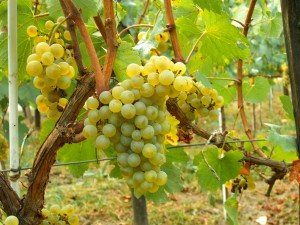Graves Region: White Wines to Buy Now
Graves Region: What to Buy Now
Bordeaux white wines are nearly always a blend of Semillon and Sauvignon Blanc grapes, unlike the Chardonnay grapes which are used exclusively for the white wines of Burgundy. This blend encourages the winemaker’s art, with Sauvignon Blanc (with its high sugar content) typically yielding aroma and fresh, fruity flavor, while Semillon tends to add finesse and balance.
The Graves (from the French word for gravel) region adjoins Bordeaux to the south. I first discovered a fine white wine from that region, however, during a trip to New Orleans!
- Chateau Olivier, one of the ten white Graves wines classified in 1959, was a find some thirty years ago, at Antoine’s, the famous New Orleans Restaurant. I knew of Antoine’s through the mystery novel “Dinner At Antoine’s” (still an entertaining read), and was intrigued to have dinner there. We were in New Orleans on vacation, and asked our waiter about house specialties. Oysters Rockefeller, he told us, was invented there for John D. Rockefeller, because he didn’t care for raw shellfish. The waiter suggested a new wine discovery of Antoine’s sommelier, Chateau Olivier Blanc, from the Graves region near Bordeaux. It cost about $15 for a bottle, as I recall. The wine was delicious, cool and refreshing. When we returned to Antoine’s last fall, we enjoyed that wine once again. It has now been discovered as an excellent wine, just right to accompany many seafood dishes. (Chateau Olivier Blanc 2011, $40). Why not enjoy a bottle at home?
If you travel to Bordeaux, your own introduction to the wines of the Graves region could well take place at the Maison des Vins de Graves in Podensac, a helpful wine information center and showcase for the hundreds of wines produced there. You will see many inexpensive wines showcased, and receive information on the region’s famous classified wines.

- I was introduced to Chateau Haut Brion Blanc, Chateau Haut Brion’s rarely tasted white wine, at a luncheon given in Bordeaux by the Mayor, former Prime Minister Jacques Chaban-Delmas. I had never heard of this wine. Our host was not surprised. He said that most of the small crop went directly to Paris for use at state dinners. It was a noble and distinctive wine, full of both body and flavor, and the only Bordeaux I have tasted that could hold its own with the great Montrachet white wines of Burgundy.
- The white wine produced at La Mission is La Ville Haut Brion is delicious. It rather resembles the best Chablis when it is aged in steel vats. Haut Brion Blanc is now priced with the most expensive red wines of Bordeaux. (I have a bottle of the legendary 1985 vintage, and am stunned to note that it now retails, usually at auction, for $830 a bottle!). Try instead a bottle of the LaVille Haut Brion from La Mission Haut Brion (2004 vintage $149). Instead, you might profit from the decision of the chateau owners, who have decided to make a second white wine from the combined stocks of Haut Brion and La Mission. This wine, La Clarte de Chateau Haut Brion Blanc, is clear and palate cleansing. (La Clarte de Chateau Haut Brion Blanc 2009 $106).
- Driving towards Leognan from Podensac, you might visit the excellent property of Domaine de Chevalier, an estate which produces both red and white wines of excellent quality (Domaine de Chevalier Blanc 2009, $109), Together with the two Haut Brion white wines, this is considered one of the three top white wines of the Graves region. The style is the lighter style of Laville Haut Brion, with breed and flavor.
- Visiting Chateau Carbonnieux, on the other side of Leognan, is a delight. In the past the property was a monastery, and the label shows a seashell that was the symbol for St. James of Compostella (and therefore was also the origin for the delicious seafood dish, Coquilles St. Jacques). There is a legend that centuries ago, Chateau Carbonnieux Blanc (now one of theclassified growths of the Graves) was sold to Ottoman rulers as “mineral water,” to get around their religious scruples about drinking wine. A member of the Sultan’s court, the story goes, was heard to ask aloud why the French bothered to drink wine, when their mineral water was so good! You may now enjoy this wine – often served as the first course at dinners in Bordeaux, for $35 (2014 vintage).
This surveys just half of the white classified growths of the Graves region. I must add as a favorite property Chateau La Tour Martillac, although I am more familiar with their fine red wine. This was the property of the French philosopher Montesquieu, whose “Spirit of the Laws” inspired America’s founders to insist on a separation of powers in the American Constitution. If you are in Bordeaux in May, perhaps you’ll be able to attend a concert at his nearby residential Chateau de La Brede. In any event, open a bottle of his white wine (Chateau La Tour Martillac Blanc 2009, $45), and promise yourself a trip to Bordeaux to spend a few days in the Graves region, and enjoy its wine bounties – both red and white!
Sign Up for our eNews articles and receive our Free Guide to Wine Tasting Like a Pro!

